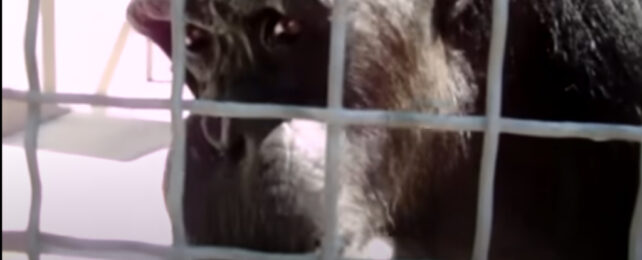Old footage of chimpanzees in captivity uttering the word "mama" suggest our closest living relatives could have the neural building blocks for speech after all.
For decades researchers have assumed differences between primate brains explain why humans alone can shape meaningful sounds. But on studying two chimpanzees seen in a publically available home video and a 1960s newsreel, KTH Royal Institute of Technology phonetician and cognitive scientist Axel Ekström and colleagues think the assumption might be based on a false premise.
"The hypothesized missing link precluding chimpanzees from voluntary jaw-voice coupling evidently does not exist," the researchers declare in their paper.
Searching through old public videos, Ekström and team found two unrelated chimpanzees (Pan troglodytes) on different continents uttering what sounds like 'mama', a word it's alleged they'd been taught by their English-speaking caregivers.
"It has been argued that 'mama' may have been among the first words to appear in human speech," explain the researchers.
The 'm' sound is common across human languages and is often one of the first sounds human babies make, so an 'm-vowel-m' pattern is relatively easy for us to produce.
Along with an earlier study, in which Ekström analyzed a sound recording of a third chimp in a 1960s television movie speaking the words 'papa' and 'cup', the findings insinuate chimpanzee brains are capable of intentionally echoing at least some of the sounds they hear.
"These results corroborate a growing body of evidence that great apes are vocal production learners," the researchers write.
This means our neurological audiovocal system – that has also developed independently in songbirds – could be much older than previously thought. Our lineage of primates last shared a common ancestor with chimps millions of years ago.
One of the videos featured a chimpanzee called Johnny from the Suncoast Primate Sanctuary in Florida.
"Johnny called everyone Mama", said the video account owner. He "knew that [saying] Mama would get him anything he wanted as long as it was on his diet…"
While chimpanzees typically favor gestures over sound when they communicate to each other in the wild, they do still use various vocalizations. What's more, their gesture based language is structured just like our vocal one. Gibbons are also known to produce more than 20 different sounds with distinct meanings.
Previous reports of primate speech had been "dismissed in the absence of rigorous analysis", but all this shows is that absence of proof is not the same as proof of absence, Ekström and team argue. They believe far too much stock has been placed in classic studies with highly questionable ethics that likely skewed their results.
Animals involved in the famous great ape language projects from 50 years ago were subjected to unnatural conditions including social isolation and neglect, often after having been traumatically removed from their mothers. This would not have allowed such obligatorily social and highly intelligent primates to fairly represent their own capabilities.
Attempts to avoid humanizing animal subjects have, at times, instead created bias at the opposite extreme, contributing to our vast underestimations of animal intelligences.
But just as science expands human knowledge in increments, our smarts are built on foundations that existed before us too.
"Great apes can produce human words," Ekström and colleagues conclude. "The failure to demonstrate this half a century ago was the fault of the researchers, not the animals."
This research was published in Scientific Reports.
